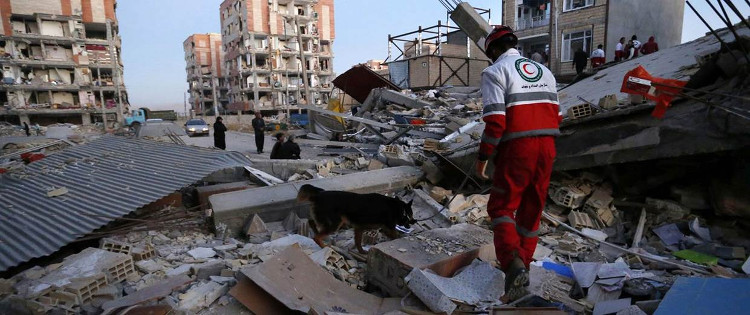Earthquake on Iran-Iraq border: There are nearly 7,000 people dead
The latest information by Iranian National Television on November 13 provides that the casualties in the earthquake disaster in the border region between Iran and Iraq have reached nearly 7,000 people, including at least 395 Iranians. network. This number is expected to continue to increase as many areas remain isolated, making rescue and rescue operations more limited.
According to the US Geological Survey (USGS), the 7.3-magnitude earthquake occurred on 21: 18 minutes on November 12 (local time, 1 hour 18 minutes on November 13 morning in Vietnam time). ) with a concussion at a depth of 2 km, 30 km from Halabja town, eastern Iraq, near the northeastern border of Iran.

Emergency relief teams are deployed to the affected area to support people.
The earthquake affected at least 14 provinces in Iran, in which Kermanshah province in western Iran was located in Zagros mountains between Iran and Iraq as the region suffered the most damage.
Iranian officials say the earthquake has destroyed more than 20 villages in the province, cutting off the electricity and water supply of the people here.
Iranian President Hassan Rouhani is expected to inspect the rescue work in Kermanshah province on November 14.
Meanwhile, the road system in the area affected by the earthquake is also seriously damaged, limiting the efforts of rescue forces in reaching remote areas. Currently, emergency relief teams carrying basic necessities have been deployed to the distressed area to support people to overcome the consequences of the earthquake disaster. Meanwhile, strong aftershocks continue to appear in areas affected by earthquakes.
Facing the current urgent situation, Iranian officials have urgently mobilized all ambulance forces, medical personnel, and helicopters ready to be prepared for rescue at Mehrabad airport in the capital Tehran. On the part of the people, many people went to blood donation facilities to help the injured.
Meanwhile, leaders and high-ranking officials from many countries continue to send condolences, expressing their deep sympathy for the Iranian government and people and Iraq after the earthquake disaster.
Russian President Vladimir Putin on November 13 sent condolences to his Iranian counterpart Hassan Rouhani, who expressed sympathy and wished the injured victims soon recovered. The minister in charge of Russia's urgent matters, Vladimir Puchkov, said the ministry is ready to support the two countries to overcome the consequences of this earthquake.

Road systems in the area affected by the earthquake were also seriously damaged.
Turkish Prime Minister Binali Yildirim has also pledged to support earthquake disaster victims in Iran and Iraq. Yildirim said the Turkish government had sent a relief team to bring medicine and food needed to help the earthquake victims. The Egyptian Ministry of Foreign Affairs also stated that it has always been close to the people of Iran and Iraq.
In June 1990, Iran suffered the most serious earthquake disaster in its modern history, destroying a series of northern Iran cities including Rudbar, Manjil and Lusan and hundreds of villages, robbed the lives of about 37,000 people.
- Earthquakes in Iran injured more than 40 people and damaged many houses
- Find the culprit causing earthquakes in Iran
- Strong earthquake in Iran, hundreds of casualties
- Iran: Hundreds of people died from double earthquakes
- 5.7 Richter earthquake near the Bushehr nuclear facility of Iran
- 9 remarkable things about Iraq
- Earthquake near Iranian nuclear plant, 30 people died
- Strong earthquake in the Mexican-American border area
- 2 people died, 200 were injured after the quake shook Taiwan
- Fallow after the earthquake in India
- Iran is highly alert to bird flu
- 4.2 Richter earthquake in Son La
 Is the magnetic North Pole shift dangerous to humanity?
Is the magnetic North Pole shift dangerous to humanity? Washington legalizes the recycling of human bodies into fertilizer
Washington legalizes the recycling of human bodies into fertilizer Lightning stone - the mysterious guest
Lightning stone - the mysterious guest Stunned by the mysterious sunset, strange appearance
Stunned by the mysterious sunset, strange appearance